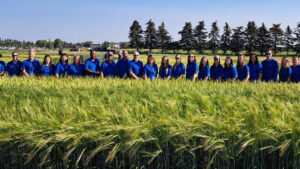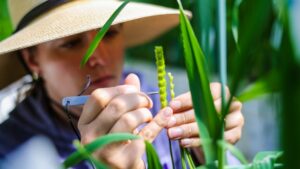At the recent Field Crop Development Centre (FCDC) Field Day held during AgSmart on Aug. 2, the transformative evolution of agricultural technology and its impact on the seed industry came into focus when Marc Zienkiewicz sat down with Jennifer Zantinge, a biotechnology research scientist at Olds College and the FCDC, to talk about the future of cereal breeding.
In an insightful conversation, she reveals the pivotal role that innovative tools play in revolutionizing the seed breeding process. Traditionally, plant breeders relied on visual assessments of plants grown in the field to make selections. However, this approach faced limitations when it came to traits that are not easily discernible through visual inspection.
Zantinge delves into the intricacies of her work, which focuses on refining and modernizing the breeding pipeline. The process involves integrating a range of technologies to enhance the accuracy and efficiency of trait selection.
“For instance, some critical traits such as milk quality and disease resistance require advanced techniques like wet chemistry or DNA analysis, as they are not readily observable by simply looking at plants,” she says.
“Over the past two decades, there has been a revolutionary shift in the cost and feasibility of employing molecular markers and DNA analysis in breeding programs. Technological progress has democratized these tools, making them more accessible and cost-effective. Innovative methodologies utilizing fluorescent dyes and specialized equipment have streamlined the analysis process, reducing labor while increasing accuracy.”
Zantinge highlights the integration of digital data collection through drones and remote sensing. These technologies provide breeders with comprehensive insights into plant performance and environmental factors, enabling more informed decisions. The amalgamation of genetic data and field performance metrics allows the creation of algorithms and predictive models to aid in the selection of ideal breeding lines, she adds.
Sustainability emerges as a central theme in the conversation. She emphasizes that sustainability has long been a priority for farmers, and advancements in biotechnology align seamlessly with this goal. Research projects centered on improving nitrogen use efficiency and disease resistance exemplify the intersection of sustainability and technology. The introduction of genomic selection—comprehensive genetic analysis of the entire genome—augments traditional marker-assisted selection methods. This approach enables breeders to tackle complex traits influenced by multiple genes.
Zantinge envisions a future where these advancements continue to shape the landscape of agriculture. The integration of artificial intelligence (AI) may become more prevalent, facilitating even more precise and informed decision-making. Ultimately, the utilization of these technologies expedites the development of enhanced crop varieties that are well-suited to changing environmental conditions and consumer preferences.












